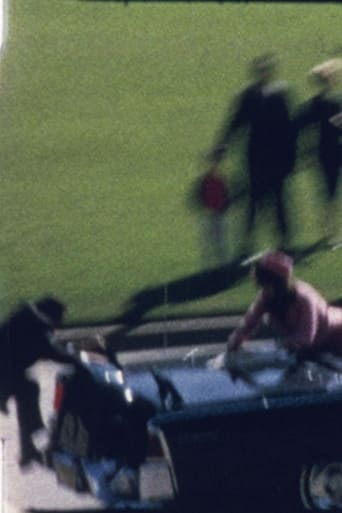frannywentzel
While the historic significance of this film is beyond critique, one should also give Herr Zapruder credit for his brilliant cinematography.First off he picked one of the best spots to get his shot. Given that he suffered from vertigo one should also credit his willingness to sacrifice his own personal well-being in the service of Art. While he wasn't able to get fully above the Stemmoms Freeway sign, one can only do so much with the set one is given.Second of note is his directorial decision to cut when he realised he'd filmed the motorcade too soon. This meant that virtually all of the assassination would be covered in the 30 second allotment covered by the spring wound camera drive mechanism.The fact that he was able to keep rolling as all Hell broke loose in Dealey Plaza even has he himself was reacting to the events should've gotten him a press photography award.It should be noted that Oswald was almost 3x as far away from Zapruder than any proposed second gunman - he was practically right on top of the so-called Grassy Knoll area and within steps of any plausible sniper lair. One would expect that upon hearing an unsuppressed gunshot from right behind and under him, Zapruder would've whipped around to get a shot. That he didn't should say something about the veracity of 'second gunman' claims.At any rate you can tell that the fatal bullet came from behind by a slight forward head movement in the same moment JFK loses the piano lessons - and I was using footage available at a pro-conspiracy site.
ackstasis
It's the magic of the motion picture. Film has given us the ability to enjoy the memorable performances of actors and actresses long gone, to experience the culture of another era and, indeed, to relive pivotal moments in history over and over again, whether we wish to or not. The assassination of US President John F. Kennedy at 12:30 PM (Central Standard Time) on Friday, November 22, 1963, in Dallas, Texas was a horrific moment in American history. For decades, endless debate has raged over the true circumstances of his death, spawning countless conspiracy theories and accusations of a CIA cover-up.There are films and still photographs taken by at least fourteen photographers in Dealey Plaza during the assassination. Of these, the footage recorded by private citizen Abraham Zapruder is the most complete visual recording of the incident. I'm not one to subscribe to these often-ridiculous conspiracy theories, so now I'll just present the facts: Zapruder captured the scene with a Model 414 PD Bell and Howell Zoomatic Director Series Camera that operated via a spring-wound mechanism, which filmed at an average frame rate of 18.3 frames per second, and recorded on Kodak Kodachrome II 8 mm movie safety film. The footage of the assassination itself runs for a total of 486 frames, or 26.6 seconds. Kennedy's limousine is visible in 343 of the frames, or 18.7 seconds.The most infamous image contained in the film is the final fatal shot to President Kennedy's head, almost exactly as the limousine passes directly in front of (and slightly below) Zapruder's position. It is truly a horrid thing to be watching, but sheer morbid human curiosity makes us simply incapable of averting our gaze. Pleasant this film is not, but its significance to American history is irrefutable.
kitkat41810
This film would be a great piece of history if in fact it was a real film of the Kennedy assassination. The are far too many mistakes in this film for me to point out. It is a film of the Kennedy assassination, but many of the important facts have been altered. There are missing scenes, and many of the scenes, after the president's limo passes the sign, don't fit in. Both Kennedys move noticeably slower then the other four people in front of them. Next time you watch this film look for things that don't add up, such as the Texas Gov. and his, along with the SS men in the front, lunge forward but you can see that the limo is not stopping or slowing down, in fact is is accelerating. This film is clearly an attempt at a cover up.



